3 Ways to Make Ponds Without Plastic Liners (and Help Save the World)
So you want to make a pond! A beautiful, natural oasis bursting with beneficial life and delighting all who experience it. A natural landmark that will forever increase the monetary & ecological value of your property!
Now ask yourself this question: How do you want to build your pond? Do you want to surround the living waters you’re creating in a petroleum product that leaches chemicals, is extremely expensive, and will eventually break down and leave you pondless?
Umm, personally, that’s a hard pass from me. Pond please, hold the plastic!
But it can be hard to know how to make a pond WITHOUT this type of toxic shell. I’ve actually made them with plastic lining before, just because I didn’t know there was any other way!
Over the past few years, I’ve been lucky enough to learn (from people far more experienced than I am!) that even in an area without existing water features, you have plenty of options to get that pond going -- no plastic needed.
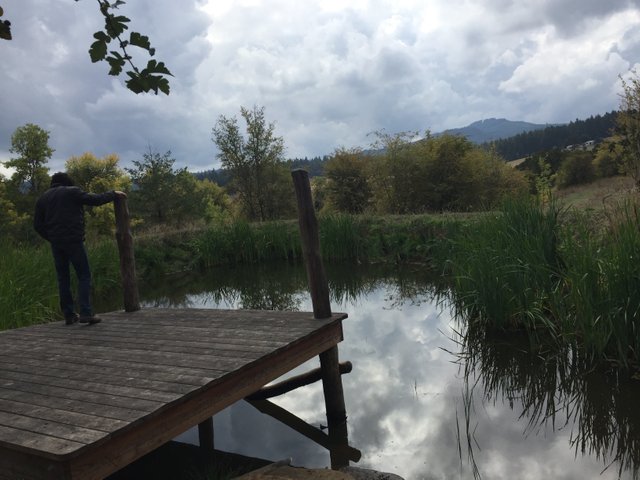
There are three ways I know of to achieve a pond without a liner:
- Dig where it’s wet
- Gleying
- Clay & compaction
But first of all... why do we even want to make a pond without a liner? What’s the big deal?
Basically: By making a pond without a liner, you are literally helping to save the world.
That may sound a little dramatic, but it’s really not! Right now, our situation is that, essentially... we're breaking our water cycle. Eventually that will mean we have nothing but ocean water. And without drinkable water, obviously we all die! So, we’re going to be way screwed if we don’t stop breaking the freaking cycle.
A natural pond is one way to help restore this water cycle.
It can sound confusing, I know!
Allow me to explain:
The hydrological cycle depends on us understanding and designing so that every part of it can take place. The problem today is...we don’t.
Right now, the water we pump from our underground wells is like a bank account that keeps getting withdrawals, but no deposits. Not good cash flow, right?
The deposits would be the water sinking down into the earth when it rains, but they’re not making it into the bank.
Why not? It still rains, doesn't it?
This water isn't able to replenish itself in most places because we’ve designed our cities to drain all our rain away to the nearest waterways. This design is a remnant from back in the days where people literally dumped sewage openly into the street, so it was important for everything to drain away quickly to spread less sewage-borne disease.
Gross and outdated, right?! Yet still to this day, we make our streets impermeable and direct all our runoff to the nearest waterway like it's sewage. We act like this water isn’t something that we need, when that couldn’t be further from the truth!
The AWESOME news, though?
Is that when we make a pond without a plastic liner, we really help reverse this damage. With a pond sealed naturally, we’re allowing it to participate in the landscape & deeply hydrate the ground, replenishing groundwater all around it - finally making much-needed deposits into that bank account! Otherwise, the pond water stays mostly separate from the ecosystem around it and isn’t helping restore our broken water cycle. Hydrologically positive ponds for the win!!!
Elemental Ecosystems' Zach Weiss talks about the importance & function of such ponds (starting at 2:30):
Now that we have some context, here are the three ways I know of to make ponds without plastic liners.
1. Find somewhere wet & dig.
Basically, just deepen an existing wet area. This can be a great option if a pond isn’t technically “legal” for whatever reason.
Sepp Holzer, Austrian “Rebel Farmer” world-famous for his pond systems, advises us on the process:
“You could, for example, find a part of your land that is naturally wet. You could remove whatever plant growth there is and use it to make low banks. [The plant growth right over where you want to start the body of the pond only!] The depression in the ground is not a hazard, because the water is not above ground level. Water will only collect in the depression. The surface of the water will only span a few square meters. In time the banks will knit together. The hollow can also be made a little deeper, which hardly anyone will notice. It will not pose a danger to anyone, because very little has actually been changed.
The resulting wetland can be made even larger using this method. Neighbours and visitors alike will enjoy watching the pond & plant life as it grows & flourishes….
In the unlikely event that a neighbour does go to the authorities to complain about the pond having no planning permission, you can explain to the officials from the water regulatory authority that it has always been there. You have only taken measures to maintain it. The value of a biotope like this far outweighs all the hard work the bureaucrats demand that we do. Do not be dissuaded from your project by seemingly incomprehensible laws or be daunted by the administrative system.” (Translated from German, just FYI.)
Page 9-10 “Sepp Holzer’s Permaculture.”
2. Gleying
Basically, you’re creating a waterproof, anaerobic seal with a decaying layer of organic material. This mimics what happens in many natural bodies of water, but is also said to be a Russian technique.
Allegedly, it is possible to gley and get a good seal with only plant material, but the very best example on the internet uses pigs! The manure layer and trampling/wallowing actions of the pigs are what make the layer of organic material & seal the pond.
Michael Newby from Mount Shasta, CA has generously posted & given permission to re-post his remarkably successful process of gleying a pond with pigs on permies.com. I know that this process might sound a little gross, but the biology takes care of any hazards from the pig manure, and this is a fantastic natural alternative to plastic. Also, gleying can even work on soil without clay in it - so it’s an excellent option if you live in a non-clayey area. Check out these before and afters and see for yourself!
Michael Newby in California has gravelly soil without much clay. In the course of two years, he went from this:
7/2014 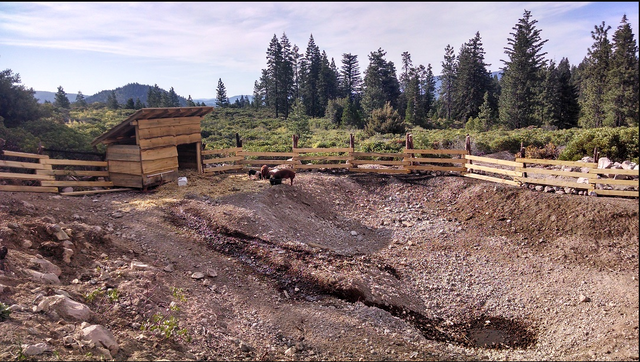
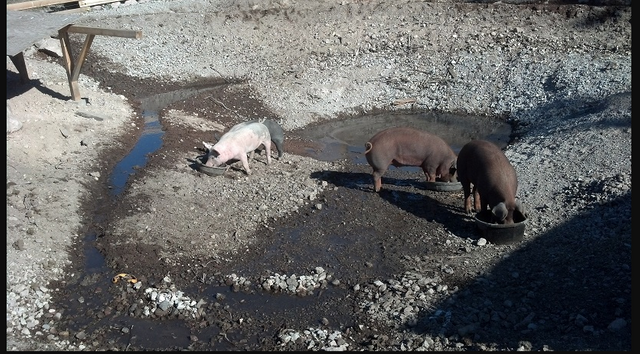
Photo credit Michael Newby, sourced from Permies.com
To this:
9/2016 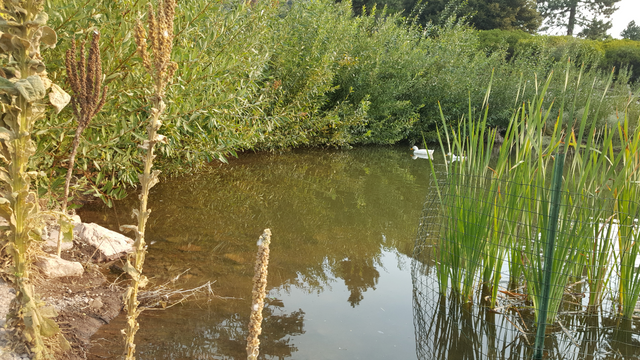
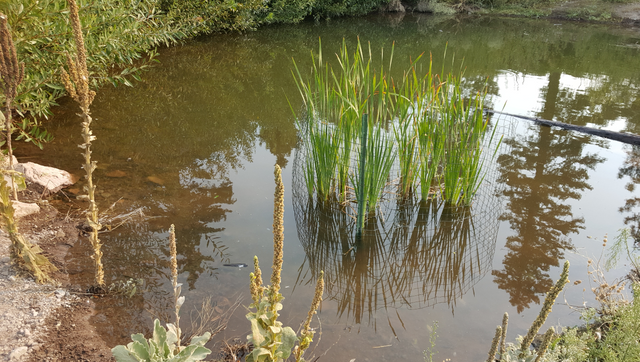
Image credit Michael Newby, sourced from Permies.com
So, yeah. Pigs can make ponds.
Read through the whole transformation here:
https://permies.com/t/38201/Progress-Gleying-Pond-Pigs
Geoff Lawton also has an animal gleying technique: He uses ducks to seal a leaky dam, and explains how it's done below.
3. Clay & Compaction
The clay method means finding and using clay on-site by shaping & compacting it to make & seal your pond. This means it’s not always possible to build a pond somewhere - for instance, on an area made of limestone shale, it’s just not going to happen. There is the option to bring in clay from off-site, but that’s really expensive & labor intensive. If you have no clay, I recommend gleying with pigs.
There's no possible way to explain the full clay dam-building process here; this is definitely a DYOR (do your own research) type of situation. Geoff Lawton has some excellent videos that take you through the process, though, and these will get you started understanding what building a pond like this entails.
2 tips for the clay pond method:
A. You really don’t know whether there’s clay under the soil somewhere until you dig! For this reason, Zach Weiss, Sepp Holzer’s globetrotting designer protegee, suggests going down deep to get the info you need: He digs multiple “test slices” to figure out where the best material is for building a pond by literally slicing out sections of earth with the excavator. Zach says he digs between 12 and 20+ test slices per pond!
B. Another essential strategy for making a pond with clay is that it’s REALLY important to separate the topsoil layer and place it carefully to the side. You can’t seal a pond with it mixed into your clay! However, this soil is also very important for growth once the pond is dug, and it’s vital to replace it on the banks & seed or mulch it immediately once finished.
So, there are the three ways to make ponds without plastic liners, and why it's so important.
I know this is a more information-dense post than many people publish, but screw our drip-feed culture!
You deserve all the information you need to empower your learning journey & help the planet, and I'm glad to be able to give it to you.
Let me know in the comments if you have any questions or need more information on anything here; I'm happy to answer questions and direct you to more resources.
And PLEASE, take this warning from Sepp Holzer to heart when thinking about making ponds:
“Naturally, great care must be taken when making larger changes to the landscape. The geological conditions must be taken into consideration to avoid landslides or gully erosion. As a result, it is always a good idea to start off slowly and gradually gather the experience you need. If you want to do something on a large scale straight away, you should seek professional advice.”
Thank you so much for reading!
xoxo,
J
Psst! Follow me on IG @green.catalyst
Your post was featured in an entry into @pifc's Curation Contest:Week 36. Posts are selected because the entrant felt you are producing great content and deserve more attention (& rewards) on your post. As such your post has been upvoted and will be visited by other members of the PIFC Community.
We are always looking for new people to join our curation efforts. This is a great way to meet new people and become part of a community that focuses on helping one another.
Want to promote a post for free and have a chance to find some other great content? Check out this week's Pimp Your Post.
The Pay It Forward community also has a Discord Channel if you are interested in learning more about us.
Thank you so much! Yay!
It's hard to make a article better than this! I actually hand dug a pond!
Omg wow! How did it go for you?
Great tutorial. Thanks for sharing these tips with us.
My pleasure!
This post is supported by $0.03 @tipU upvote funded by @share2steem :)
@tipU voting service guide | For investors.
Incredible post. Lots of interesting and useful information. Sadly, I live in a flat. I couldn't build a pond even if I wanted to.
PS: I've found your post after @matkodurko featured you in his entry for the Pay It Forward Contest
So glad you find it useful! Thanks for the love :)
Man, you could have easily split this article into 3 - one per each way of doing it. It's hard to find readers for such long texts here on Steemit. Even I didn't finish it as ponding is not really my thing.
But I've tried to dig out some help/tutorial/community like posts into my @pifc submission this week and this one definitely is undervalued. Hope you get more attention now :)
A really nice, but really really big post :D
But I guess it's not easy to describe how to make a pond.
really like your pif-curations ;)
Ahaha, I guess it is a little too big! I just hate to leave anything out, lol!! I appreciate you commenting :)
Ah, I know I could have, but it felt wrong to split it up! It's all so interconnected. Thanks so much for reading!
Great post glad I found it due to it featured in the pay it forward contest.
Great tutorial @jennislay! This is something that many homesteaders here would love to see! I found it because @matkodurko featured you in his Pay it Forward Curation Contest entry, but I'm also going to submit this to c-squared; hopefully they can show their support before post payout :)
This post was shared in the Curation Collective Discord community for curators, and upvoted and resteemed by the @c-squared community account after manual review.
@c-squared runs a community witness. Please consider using one of your witness votes on us here
What an amazing article! I knew there would be a good way of making a pond without plastic, but I'd never seen it until now. Thank you so much for sharing! I found it thanks to @matkodurko featuring you in the Pay it Forward Curation contest for this week. Keep up the great work!